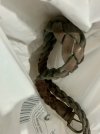I have a question. I had some really nice, new leather coats hanging in a closet with an adjacent bathroom wall. I noticed the closet wood soggy and realized there was a leak causing mould to form. I inspected the coats and they didn't have any mould on them. However there was some on the closet floor which I later cleaned. I dusted the coats and moved them to a different closet in another room. It's been a few months since this happened. Today I noticed a leather belt full that was kept on the floor of the closet right under these coats, full of mold. The brown leather belt had almost turned greenish, I removed it from the closet and observed some dusty green mold on the floor of the closet. I inspected all the leather coats and none of them have any visible mould inside or out. Not even small specks.
Can someone help me understand and perhaps suggest what I should do to preserve these coats? Is it possible the leather coats have mold which I cant see or theyre resistant to having it grow on it but the belt that was underneath them had mold falling on it from the coats an the belt's leather was prone to this mold? I just dont know what to make of it and what to do to keep the coats safe and clean from mold. I am attaching a pic of the said belt.
Can someone help me understand and perhaps suggest what I should do to preserve these coats? Is it possible the leather coats have mold which I cant see or theyre resistant to having it grow on it but the belt that was underneath them had mold falling on it from the coats an the belt's leather was prone to this mold? I just dont know what to make of it and what to do to keep the coats safe and clean from mold. I am attaching a pic of the said belt.

